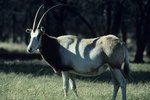
Don't feel bad if you've confused a musk ox with a yak. These large members of the family bovidae have similar traits, including long, shaggy coats and impressive horns. Despite being herbivores, each of these guys makes an imposing presence. There are more differences than similarities between the two.
Home
If you're in search of a musk ox, you'll likely need to head north to find him. They're native to Canada and Greenland and, in the 1930s, were reintroduced to Alaska. They've also been introduced into Siberia, Russia and Norway. The habitat of musk oxen provides a very short growing season in the summer, giving them abundant vegetation for food in the summer. Winters are long and cold, with harsh winds and little precipitation. If you're looking for a yak, confine your search to parts of China, Tibet and India. Yaks are usually found in alpine meadows or alpine or desert steppes. They prefer the plateaus' colder temperatures, and altitudes below 9,000 feet are difficult for them because of their sweat glands and heavy coats.
Physical Characteristics
Both of these guys are big, but the yak is the larger of the two. Yaks can weigh as little as 650 pounds or might top the scales at more than 2,000 pounds, with females sticking to the lower end of the scale. Yaks have large lungs and a high red blood cell count, so those living at high altitudes in the Himalayas thrive and don't suffer from altitude illness. The musk ox ranges from 400 pounds to nearly 900 pounds. Both sport dual coats for extra winter protection, shedding the undercoat during warmer months.
Diet
Musk oxen and yaks are herbivores and their diets are dictated by habitat. Some yak herds seasonally migrate to eat moss, grass and lichens. Most yaks graze on low-lying grasses and plants, including shrubs, and they'll eat snow if they need water. Musk oxen are grazers, too, eating just about any vegetation they come across. During the summer, their diet is heavy on grasses, shrubs, herbs, leafy plants and mosses. It changes to roots, willow and dwarf birch stems during the winter, when they're assisted by the large stores of fat they build through the summer.
Socializing
Both animals live in herds, though herding habits are different. Musk oxen live in smaller herds during the summer, usually of about 10 to 20 animals, though herds can contain as few as five. During the winter, herd size can grow to 60 animals. Yak herds tend to be divided according to gender, with herds ranging from 20 to 200. Typically, about 10 or 12 males will group together, while the females and young yaks stay in larger groups, ranging from as few as 10 to 12 to as many as 200 members.
References
Photo Credits
-
Hemera Technologies/Photos.com/Getty Images




